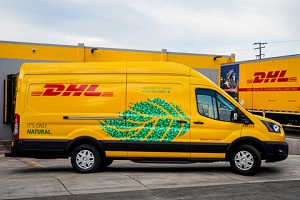PowerFlex installs 415 electric vehicle supply equipment for DHL Express in US

PowerFlex completed the installation of 415 electric vehicle supply equipment (EVSE) for DHL Express. The chargers, installed at DHL service centre facilities in major US markets, are equipped with PowerFlex X, energy management software that monitors, tracks, and reports on charging activities, integrating with DHL’s telematics platforms to optimise electric vehicle supply equipment (EVSE) operations.
The initiative demonstrates the commitment of DHL to sustainability as the company electrifies its fleet to reduce its climate impact and foster eco-friendly operations. DHL says it is the first logistics company to commit to a zero-emissions target, and their fleet electrification is a step in their green logistics plan.
PowerFlex completed the initial installation with DHL in 2020 and customised the EVSE project and subsequent ones to optimise the charging experience around the daily delivery operations of DHL. The charging stations were installed overhead to keep them out of the vehicles’ path of travel, yet remain accessible for drivers to plug in at the end of the day.
By reviewing the logistical needs of each fleet depot, PowerFlex recommended that DHL install Level 2 (L2) charging stations, which are typically more reliable, economically priced, and less power-intensive than Level 3 DC (direct current) fast chargers. Another benefit of PowerFlex Level 2 chargers is the ability to increase the number of chargers onsite to enable future expansion or provide spare chargers as backup if necessary.
PowerFlex L2 chargers are equipped with adaptive load management (ALM), intelligent energy management software that balances the power usage across the network of chargers to minimise expensive spikes in energy demand. With ALM, DHL was able to install double the number of chargers in comparison to unmanaged charging with the same power limit and onsite utility infrastructure. Additionally, by mitigating spikes in energy demand, ALM is the grid-friendly EV charging technology that helps prevent overtaxing the existing electricity grid.
“At DHL Express, we are always looking for ways to make our operations more sustainable,” says Laurice Bancroft, SVP of network operations for DHL Express U.S. “Fleet electrification is one of the many strategies we’ve deployed to reduce our carbon footprint as we work toward our goal of zero-emissions. We selected PowerFlex to complete our EV charging stations because of their deep industry experience that helped us find a creative solution to meet our EV fleet charging needs. We look forward to scaling up our EV fleet and ensuring reliable, eco-friendly deliveries to our customers.”
“DHL is taking a thoughtful approach to adopt new ‘fueling’ for its business needs and exploring the possibilities offered by in-house EV charging,” says Raphael Declercq, CEO of PowerFlex. “We are proud to work with DHL to support their fleet electrification. PowerFlex’s team understands the critical importance of ensuring that last-mile delivery vans are fully charged to support on-time deliveries while meeting DHL’s fleet sustainability goals.”
For these EVSE projects, PowerFlex provided DHL a suite of services, including site feasibility assessments, turnkey design and installation, hardware and software solutions, and asset management and operations and maintenance services.
Comment on this article below or via Twitter @IoTGN
